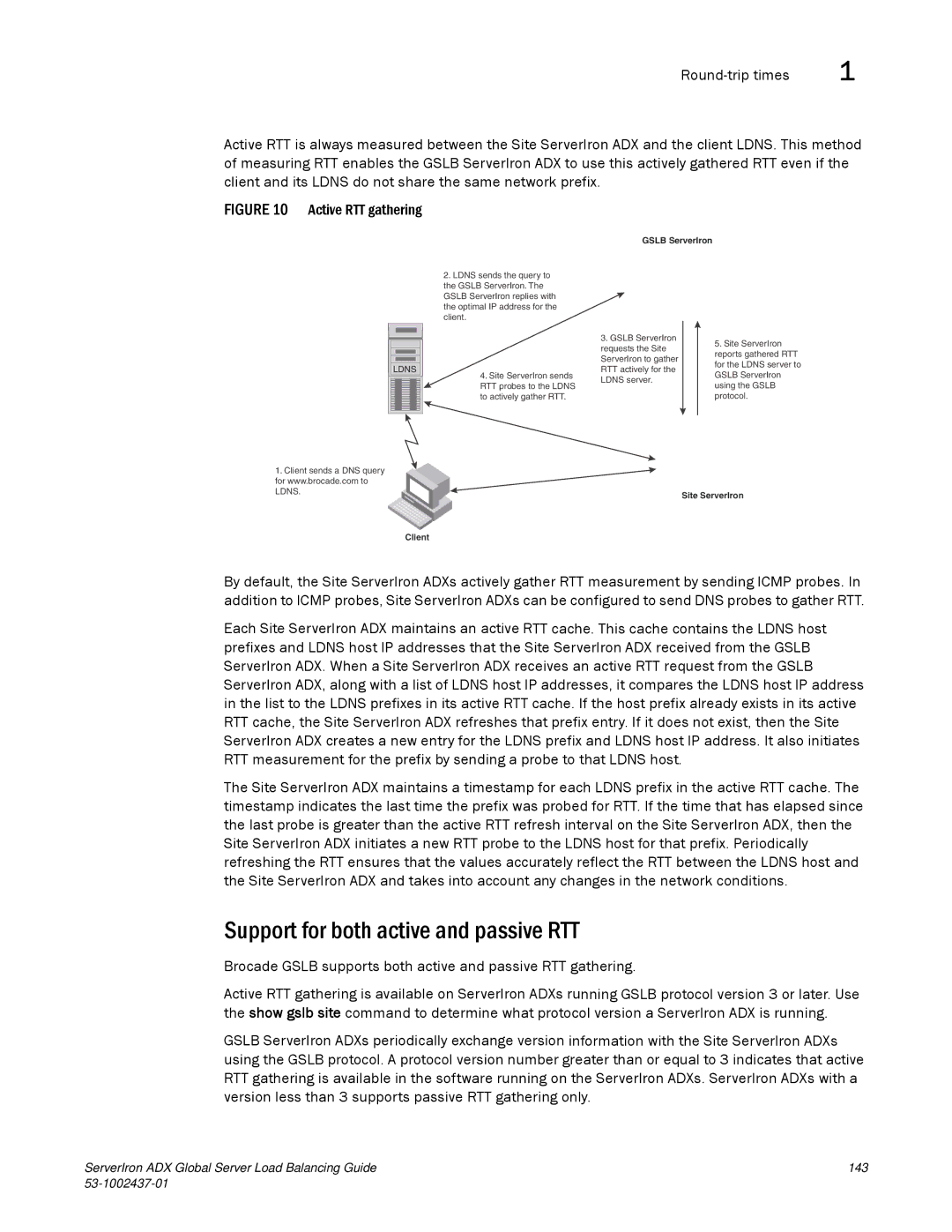
1 |
Active RTT is always measured between the Site ServerIron ADX and the client LDNS. This method of measuring RTT enables the GSLB ServerIron ADX to use this actively gathered RTT even if the client and its LDNS do not share the same network prefix.
FIGURE 10 Active RTT gathering
GSLB ServerIron
2.LDNS sends the query to the GSLB ServerIron. The GSLB ServerIron replies with the optimal IP address for the client.
LDNS
1. Client sends a DNS query for www.brocade.com to LDNS.
Client
4.Site ServerIron sends RTT probes to the LDNS to actively gather RTT.
3. GSLB ServerIron |
| 5. Site ServerIron |
| ||
requests the Site |
| |
| reports gathered RTT | |
ServerIron to gather |
| |
| for the LDNS server to | |
RTT actively for the |
| |
| GSLB ServerIron | |
LDNS server. |
| |
| using the GSLB | |
|
| |
|
| protocol. |
|
|
|
|
|
|
Site ServerIron
By default, the Site ServerIron ADXs actively gather RTT measurement by sending ICMP probes. In addition to ICMP probes, Site ServerIron ADXs can be configured to send DNS probes to gather RTT.
Each Site ServerIron ADX maintains an active RTT cache. This cache contains the LDNS host prefixes and LDNS host IP addresses that the Site ServerIron ADX received from the GSLB ServerIron ADX. When a Site ServerIron ADX receives an active RTT request from the GSLB ServerIron ADX, along with a list of LDNS host IP addresses, it compares the LDNS host IP address in the list to the LDNS prefixes in its active RTT cache. If the host prefix already exists in its active RTT cache, the Site ServerIron ADX refreshes that prefix entry. If it does not exist, then the Site ServerIron ADX creates a new entry for the LDNS prefix and LDNS host IP address. It also initiates RTT measurement for the prefix by sending a probe to that LDNS host.
The Site ServerIron ADX maintains a timestamp for each LDNS prefix in the active RTT cache. The timestamp indicates the last time the prefix was probed for RTT. If the time that has elapsed since the last probe is greater than the active RTT refresh interval on the Site ServerIron ADX, then the Site ServerIron ADX initiates a new RTT probe to the LDNS host for that prefix. Periodically refreshing the RTT ensures that the values accurately reflect the RTT between the LDNS host and the Site ServerIron ADX and takes into account any changes in the network conditions.
Support for both active and passive RTT
Brocade GSLB supports both active and passive RTT gathering.
Active RTT gathering is available on ServerIron ADXs running GSLB protocol version 3 or later. Use the show gslb site command to determine what protocol version a ServerIron ADX is running.
GSLB ServerIron ADXs periodically exchange version information with the Site ServerIron ADXs using the GSLB protocol. A protocol version number greater than or equal to 3 indicates that active RTT gathering is available in the software running on the ServerIron ADXs. ServerIron ADXs with a version less than 3 supports passive RTT gathering only.
ServerIron ADX Global Server Load Balancing Guide | 143 |
|
